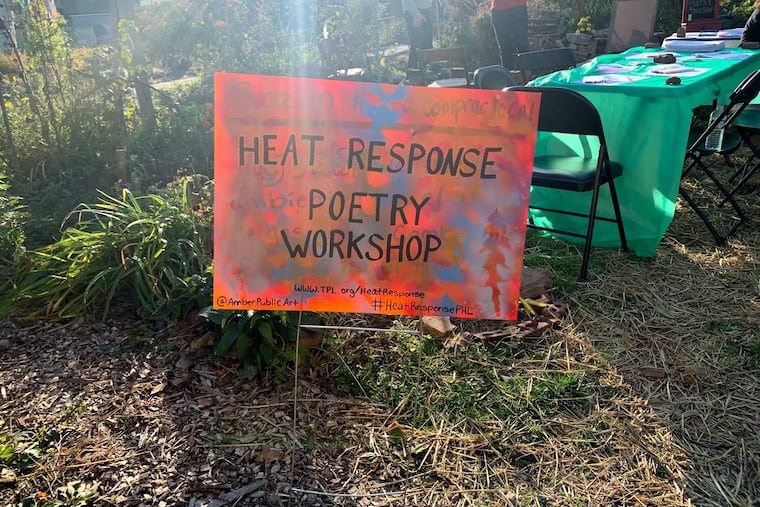Extreme heat in Philly should be a year-round concern | Opinion
Some neighborhoods are hit especially hard. One tool to help: art.

The impacts of climate change are felt across the country in various ways, from wildfires to floods, droughts to hurricanes. In Philadelphia it manifests in extreme urban heat, a multi-faceted threat with negative impacts on our physical, mental and social health. Heat waves are the deadliest form of weather, according to data from the National Oceanic and Atmospheric Administration. Extreme heat creates heightened risks for those with asthma, hypertension, and heart and pulmonary disease. Research also shows that extreme heat in school settings impacts test performance and a student’s long-term learning.
Heat hits some Philadelphia neighborhoods especially hard. One important tool for those residents is having space to express their lived experiences of extreme heat through public art—while developing local solutions. The Heat Response project connects local artists and community leaders with residents of three neighborhoods to tackle the problem.
While the neighborhoods where the Heat Response Project is focused—Southeast Philadelphia, Grays Ferry, and Fairhill— all have extreme heat in common, the impacts differ. The Heat Response project has built neighborhood teams, each joining a local artist and community members to answer the questions: Why should we care about urban heat and what can we do about it?
» READ MORE: Climate change makes some Philadelphia neighborhoods extra steamy. The city has a plan.
It starts with understanding how this became a problem. Due to redlining practices and generations of disinvestment, low-income communities and communities of color experience hotter temperatures than surrounding neighborhoods. These hotter temperatures are created by an urban heat island effect, when lack of green space, an abundance of blacktop surfaces that absorb heat, and dense housing combine to elevate temperatures. On a day that is 82 degrees in Love Park, temperatures soar elsewhere — Southeast Philadelphia feels 87.5 degrees, Grays Ferry hits 89.5 degrees, and Fairhill tops the three at 90 degrees.
Councilwoman Katherine Gilmore Richardson, who grew up in North Philadelphia, a neighborhood with few to no trees or green space, said it best at a kickoff event introducing Heat Response to the city this fall: “In Philadelphia, your ZIP code determines your life expectancy.”
In Southeast, residents participating in community workshops said that even having lived in other places we might imagine as hotter than Philadelphia, such as Puerto Rico, Mexico, and the Philippines, the heat they experience now is different. It feels much hotter living in a neighborhood locked in asphalt. There are fewer opportunities for relief. A community garden that provides shade with a grass patch for laying down a blanket on hot days was cited as a welcome refuge from summer heat. For others, small home gardens with plants and a pergola could make a summer day outdoors “bearable.”
Action on the growing climate emergency — and extreme urban heat specifically — must be a local priority, and not limited to summer months. Extreme urban heat is becoming inescapable for so many communities, and its health and economic consequences are harming our most vulnerable neighbors. We have to act now.
» READ MORE: Creating a more equal America demands more urban green spaces | Opinion
First, we must invest time and resources to identify challenges from within communities. We are already hearing a common thread in postcard responses to our project, in poetry and in artwork: Green space is a refuge, but there’s not enough of it where people need it most.
Second, we must bring these concerns and challenges to legislators, who have policy and power at their disposal. Urban planning, climate mitigation, housing, and stormwater infrastructure are just some of the sectors that affect the way residents experience and live with the extreme heat impacts of climate change and for which city officials are responsible.
Third, we must invest in sustainable solutions. Last summer, extreme heat became even more of a challenge when the public resources that provide heat relief, including pools, community cooling centers, and libraries, shuttered to prevent the spread of COVID-19. The resulting struggles made all the more clear how badly we need more local green space as relief from the heat.
Within our cities and communities, what we should do to mitigate extreme heat will vary, but the starting point is the same: listening to residents about local solutions that will work for them. We are excited to continue these artistic expressions and solutions in Philadelphia the coming year.
Owen Franklin is the Pennsylvania State Director for The Trust for Public Land. José Ortiz-Pagán is a visual artist, curator and cultural organizer working in Southeast Philadelphia for the Heat Response Project.